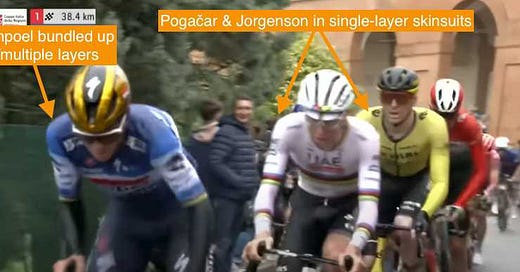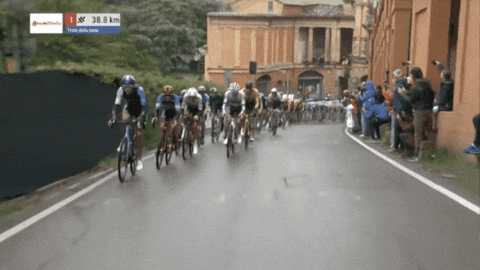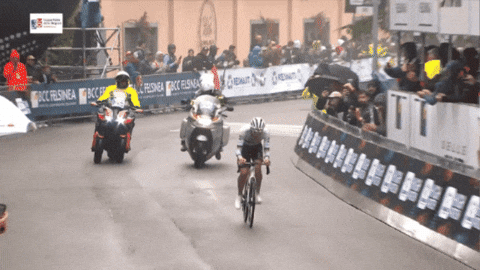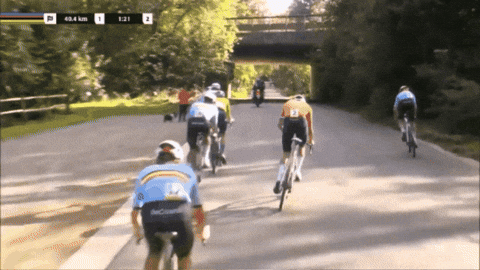Key Takeaways: Tadej Pogačar & Mathieu Van der Poel's Late-Season Dominance
Breaking down a few highlights and finding the key takeaways from a busy weekend of racing at the Giro dell'Emilia & UCI Gravel World Championships
Amidst the non-stop flurry of racing over the past weekend, Tadej Pogačar continued his dominant, and potentially greatest ever, 2024 season by winning the Giro dell'Emilia in the cold, rainy weather of Bologna after leaving a star-studded field in the rearview by floating clear of the group on the first of five passes of the climb to the Basilica di San Luca, eventually crossing the line to seal the win nearly two minutes ahead of second-place finisher Tom Pidcock. Meanwhile, Mathieu van der Poel confirmed that speed over roads, cobbles, and singletrack does indeed translate to speed on gravel paths when he won the 11th career World Title after powering away from an elite front group to win the UCI Gravel World Championships in the picturesque forest paths surrounding Leuven, Belgium (while Marianne Vos won her 14th World Title in the women’s race). Below are the top highlights and key takeaways from these races:
Giro dell’Emilia
Final Top Five:
1) Tadej Pogačar (UAE Team Emirates) +0
2) Thomas Pidcock (INEOS Grenadiers) +1’54
3) Davide Piganzoli (Team Polti Kometa) +1’54
4) Michael Woods (Israel-Premier Tech) +1’54
5) Simon Yates (Jayco AlUla) +2’02
Race Notebook
38.8km-to-go: Heading into the first pass of the San Luca after 176 kilometers of hard racing in wet/cold weather, Remco Evenepoel takes the front after looking over and seeing Tadej Pogačar moving up.
38.4km: Once on the front, Evenepoel immediately raises the pace. While this is an apparent effort to press his rivals and thin the field, the fact that he is still wearing multiple layers of warm clothing while Pogačar and Matteo Jorgenson have stripped down to lightweight skinsuits tells us that Evenepoel is likely struggling in the cold weather and that this attack may be short-lived.
37.6km: After a taut leadout from Evenepoel and an Astana rider, Pogačar riders clear on the steepest slopes of San Luca. Behind, Evenepoel is nowhere to be seen, while Jorgenson is the only rider who has attempted to respond.
37km: Pogačar crosses the summit of the climb after having opened up a 26-second gap on Jorgenson and a 35-second gap on the peloton.
28.3km: On the following lap’s pass of San Luca, Pogačar has a comfortable 45-second gap on the peloton, which has no concerted chase. RedBull-Bora’s Florian Lipowitz attacks and builds up a small gap as his teammate and three-time winner of this race, Primož Roglič, sits in the group, looking off his best.
Pogačar Finish: After three more climbs on San Luca, Pogačar continues to increase his lead, and comes over the finish line with a massive advantage as Polti-Kometa’s Davide Piganzoli attacks the peloton behind.
Chase Group Finish: Tom Pidcock sprints over the line to take second place nearly two minutes later, with Piganzoli picking up an impressive third place behind.
Key Takeaways
1) Tadej Pogačar Remains Tactic-Proof by Out-Anticipating Rivals Who Attempt to Get In Front of His Attacks: The star of 2024 continues to put the finishing touches on what is likely the most dominant season in modern professional cycling history. Part of what has made this season so bountiful for Pogačar is his ability to continue to redefine what is possible by attacking further and further from the finish line. As rival teams and riders attempt to anticipate his attacks, he just continues to stretch out his final move, attacking from 100 kilometers out at the World Championships and forging clear on the first of five passes of San Luca.
After this win at Emilia, he has 24 2024 wins, which is the most from a single rider in a season since Alessandro Petacchi in 2005 (25). This is especially impressive when we consider that Petacchi was a sprinter and had far more chances to win than Pogačar (he raced 21 more race days in 2005 than Pogačar did this season), and Pogačar’s 2024 total is beginning to creep near the career totals of all-time great Grand Tour winners.
For context, Vincenzo Nibali, who was a professional for 17 seasons and one of the best all-around racers of his era, won 54 races throughout his entire career, while Chris Froome 46 (I’m comfortable calling that number even though Froome is still racing), and Jonas Vingegaard, one of the two best current stage racers in the sport, has 36 wins, only 12 more than Pogačar has in the last year.
Furthering comparisons to the sport’s all-time great, Pogačar’s win on Saturday makes him the first Tour winner to win Emilia in the same season since Eddy Merckx did it in 1974.
But, what makes Pogačar’s 2024 season so impressive is that even relative to the two other Treble winners (Merckx in 1974 and Stephen Roche in 1987), Pogačar has rarely had a glove laid on him all season long.
Outside of losing Milano-Sanremo (aka ‘The Sprinter’s Classic) to the world’s best sprinter, GP Québec, a Tour de France time trial (Stage 7), and the epic duel against Jonas Vingegaard on the Tour’s 11th stage, everything has gone exactly Pogačar’s way throughout the entire season, with the total number of kilometers where he was even made slightly uncomfortable almost non-existent.
Meanwhile, Merckx won the Giro by only 12 seconds in 1974 before being distanced by Raymond Poulidor on multiple tough mountain stages at the Tour, and Roche beat Pedro Delgado by just 40 seconds at the Tour in 1987.
2) The Game is Clearly Changing: Something I want to spend more time on this coming off-season is examining the ever-expanding phenomenon of the sport’s best riders riding at an extremely high level and winning across the entire season. Clearly, riders like Pogačar and Van der Poel must be operating under the assumption that form sharpened in October helps them as they begin to build into 2025, which is a drastic departure from the old way of thinking, which was in vogue until recently, where stars would wind down in the fall and spend seven months building back to their top form.
If we look at Pogačar’s climbing times of the San Luca climb on Saturday versus his ascent back in the Tour in June, it becomes obvious that he is close, if not at, the form we used to win the sport’s biggest race in the middle of summer and clear that we are seeing a ‘stretching’ of top form that we haven’t seen until very recently.
Pogačar San Luca Climb Times:
1) TdF Stage 2 (June 30th): 5’062) Giro dell'Emilia lap 1 (October 5th): 5’17
3) Giro dell'Emilia lap 2 (October 5th): 5’30
4) Giro dell'Emilia lap 3 (October 5th): 5’43
5) Giro dell'Emilia lap 3 (October 5th): 5’52Considering that the Tour’s second stage was contested on a much ‘faster’ hot summer day, while Saturday’s took place in cold, driving rain, his Emilia form seems even more impressive.
3) Pogačar’s Top Rivals Suffered Mixed-Bag Days: Remco Evenepoel and Primož Roglič, two of his biggest rivals for this race and for this weekend’s Lombardia, dropped out after looking mortal (and miserable) in sub-par weather in a non-target race while suffering from what looked like normal end-of-season malaise.
Meanwhile, Tom Pidcock did well to finish second, and it looks like the rider Ineos likely envisioned they were getting when they signed him to a massive long-term deal.
However, even with one of his best road performances on the season, he still finishes two minutes behind Pogačar and never appears capable of challenging him, which highlights one of the reasons he is unlikely to win a Grand Tour or Monument in 2025, and is why Ineos may be looking to move off his current contract.
The fact that Pidcock chose this race to focus on in his run-up to Lombardia over the Gravel World Championships, which was likely a higher-profile race, tells us how serious he is taking this fall road campaign.
UCI Men’s Gravel World Championships
Final Top Five
1) Mathieu van der Poel (Netherlands/Alpecin) +0
2) Florian Vermeersch (Belgium/Lotto-Dstny) +1’03
3) Quinten Hermans (Belgium/Alpecin) +3’47
4) Jasper Stuyven (Belgium/Lidl-Trek) +3’47
5) Gianni Vermeersch (Belgium/Alpecin) +3’48
Race Notebook:
75.6km-to-go: Inside the final 100 km, Mathieu van der Poel is in a 16-rider lead group. At first glance, he appears to be outnumbered with ten riders from the Belgian squad and only a single Dutch ‘teammate’ present, but due to the individual nature of the event, the lack of any real structure behind the national gravel teams, and the presence of multiple Alpecin-Deceuninck teammates, the risk to Van der Poel is minimal.
74.8km: Van der Poel is in a good position, with members of the Belgium team driving hard at the front, making the race hard and setting up an eventual attack. This might look odd, but if we look at the Alpecin-issued Canyon/Abus helmets of the riders pushing the pace, it becomes clear that this is a transnational strategy to deliver Van der Poel the win.
40.4km: When the group exits the gravel and goes onto the pavement, Belgium’s Florian Vermeersch sees an opportunity to get clear while the others attempt to take a brief break, and attacks. Van der Poel immediately follows.
40.3km: Even with Van der Poel on his wheel, Vermeersch keeps pushing the pace, likely knowing that if he gets clear with Van der Poel, he will secure a second place. While driving, he looks back in almost disbelief at the lack of response from his Belgian teammates/rivals, the majority of which are Van der Poel’s Alpecin teammates, who are simply watching the race win ride up the road.
39.1km: Behind, we can see that Belgians Gianni Vermeersch (19) and Quinten Hermans (17) are almost deliberately slowing things down to allow their trade teammate Van der Poel to build up an advantage, while non-Alpecin Belgian Jasper Stuyven (16) gets to the front to drive the pace.
13.5km: After Vermeersch puts in a lot of work driving the pace, Van der Poel launches a hard attack on a slight uphill paved stretch of road. Vermeersch’s willingness to work with Van der Poel and his non-response to the attack confirms that he is all-in for second place.
Finish: After weaving his way through packs of age-group riders in the final kilometers, Van der Poel cruises to victory in the picturesque center of Leuven.
Key Takeaways
1) Get Used to the World’s Best Road Riders Winning Premier Off-Road Events: Combined with Marianne Vos’ win in the Women’s race, Van der Poel’s win has caused some to fret over the future place of Gravel. After all, if presumed roadies can roll up and win a premier off-road World Championship, what exactly is the point of it being a separate discipline?
However, this surface-level take omits the fact that Mathieu van der Poel is one of the sport’s best off-road riders, with multiple Cyclo-cross world titles and Mountain Bike World Cup wins.
Also, when races leave the pavement, riders with superior power and bike handling skills—which the current top road riders all have—have a tremendous advantage.
And, when courses feature a mix of off-road sectors and pavement, like Sunday’s championship, it provides the more powerful riders the perfect launchpad to ride clear of their less-powerful competition, which slows down on the pavement sectors in an attempt to recover.
There is also the simple fact that riders like Van der Poel, Pidcock, who has won the last two Olympic Mountain Bike titles, Wout van Aert, and even Pogačar are all the sport’s best riders and would dominate on any variety of terrain in any discipline.
This may make it difficult for sub-disciplines to establish their own stars, but it is just a simple byproduct of the extremely high level we are currently seeing in road racing.
The sport's simple economics, which incentivize the top off-road talents to gravitate towards the road, mean this will likely continue.
2) Gravel Racing’s Lack of Solid Team Tactics Gives a Massive Advantage to the Ultra-Elite Riders: While the winners (Vos and Van der Poel) and course may have looked similar to many high-level road races, one thing that stuck out as distinct and unique was the lack of any discernible organized team tactics.
While the Belgian team had numerical superiority in theory, in practice, the lack of professionalism in Gravel and its individualistic structure meant that the national ‘teams’ mattered for little, and Van der Poel was free to divide and conquer the front group.
Additionally, with so many Alpecin riders in the front group, three in the top five, and five in the top 11, Van der Poel had plenty of secret teammates willing to slow down the chase once he got clear.
Fans may chafe at this tactic, but without the professionalism and structural support present in road racing national teams, it makes perfect sense that riders would defer to the de facto boss of the team that pays their hefty salaries.
A preview for Il Lombardia, 2024’s final major race, coming this Friday…

















